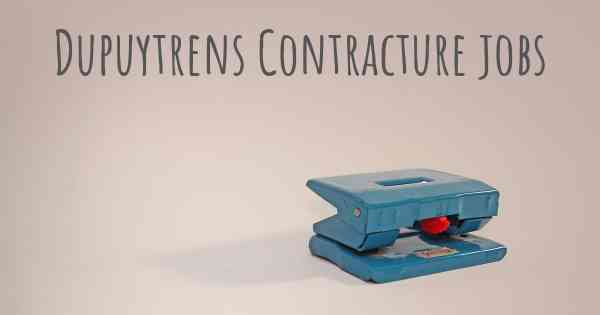Can people with Dupuytrens Contracture work? What kind of work can they perform?
See how people with experience in Dupuytrens Contracture give their opinion about whether people with Dupuytrens Contracture can work and what kind of jobs are more appropriated for people with Dupuytrens Contracture

Can people with Dupuytren's Contracture work?
Dupuytren's Contracture is a condition that affects the hand and fingers, causing the tissues in the palm to thicken and form nodules or cords. As the condition progresses, it can lead to the fingers being pulled towards the palm, making it difficult to straighten them. This can significantly impact hand function and dexterity, which may raise concerns about a person's ability to work.
However, the impact of Dupuytren's Contracture on an individual's ability to work can vary depending on the severity of the condition, the specific job requirements, and the individual's overall health and adaptability. While some individuals may experience limitations in certain occupations, many people with Dupuytren's Contracture are still able to work and perform a wide range of jobs.
Factors influencing work capabilities:
1. Severity of the condition: The severity of Dupuytren's Contracture can vary from mild to severe. In mild cases, where the contracture is minimal and does not significantly affect hand function, individuals may be able to continue working without any major limitations. However, in more severe cases where the fingers are significantly bent or unable to straighten, certain occupations may become challenging.
2. Job requirements: The type of work an individual performs plays a crucial role in determining their ability to continue working with Dupuytren's Contracture. Jobs that require fine motor skills, manual dexterity, or heavy use of the hands may pose challenges for individuals with severe contractures. However, many occupations do not heavily rely on hand function and can be performed effectively despite the condition.
3. Adaptability and accommodations: With the right accommodations and adaptations, individuals with Dupuytren's Contracture can often continue working in their chosen field. Employers can make modifications to the work environment or provide assistive devices to help individuals overcome limitations caused by the condition. Occupational therapists can also provide guidance on adaptive techniques and tools that can enhance hand function and enable individuals to perform their job tasks effectively.
Potential job options:
While the suitability of specific jobs may vary depending on the individual's unique circumstances, here are some potential job options that individuals with Dupuytren's Contracture may consider:
1. Office-based jobs: Many office-based jobs involve minimal use of the hands and can be performed effectively even with limited hand function. Examples include administrative roles, customer service, data entry, accounting, and various desk-based jobs.
2. Consulting and advisory roles: Individuals with expertise in a particular field can consider transitioning to consulting or advisory roles where they can utilize their knowledge and experience without extensive physical demands.
3. Teaching and education: Jobs in the education sector, such as teaching, tutoring, or training, often involve more verbal communication and cognitive skills rather than heavy reliance on hand function.
4. Research and analysis: Careers in research, data analysis, or market research often involve working with computers and analyzing data, which can be done effectively with limited hand function.
5. Management and supervisory roles: Individuals with extensive experience in their field can consider transitioning to managerial or supervisory positions, where they can oversee and guide others without the need for extensive manual dexterity.
6. Entrepreneurship: Starting a business or working as a freelancer allows individuals to have more control over their work environment and make necessary adaptations to accommodate their condition.
Conclusion:
While Dupuytren's Contracture can present challenges in certain occupations, many individuals with the condition are still able to work and perform a wide range of jobs. The severity of the condition, job requirements, adaptability, and accommodations all play a role in determining an individual's ability to continue working. With the right support, accommodations, and adaptive techniques, individuals with Dupuytren's Contracture can often find suitable employment options that allow them to maintain their livelihood and pursue fulfilling careers.
Early stage condition has no significant impact on any field
Advanced Dupuytren's will prevent the use of the hand due to the club finger.
I estimate that 85% - 90% of people with the condition are not hindered in their work
Posted Sep 10, 2017 by Jim 4055








